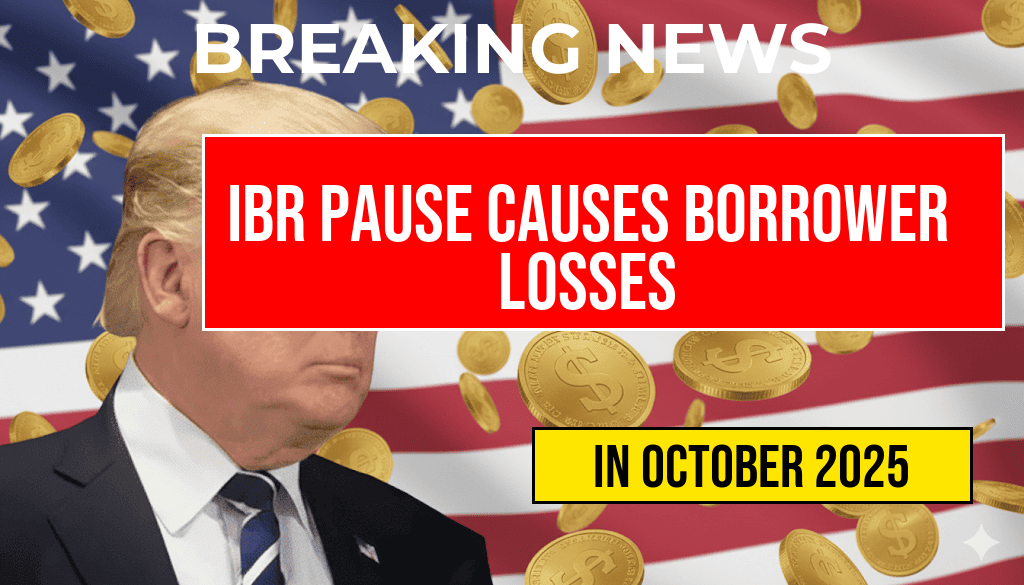IBR Pause Causes Financial Hardship for Borrowers, Promises of Refunds Underway
Hundreds of borrowers across the United States faced unexpected financial setbacks after a recent pause in income-based repayment (IBR) plans led to significant monthly payment increases for some. This temporary suspension, enacted by the Department of Education to address administrative issues, inadvertently caused disruptions for borrowers relying on these plans to manage student debt. While officials have assured affected individuals that refunds are forthcoming, the timeline remains uncertain, leaving many in a state of financial limbo. The situation highlights the complexities of federal student loan programs and the urgent need for transparent communication during administrative adjustments.
Background on the IBR Program and Recent Changes
The Income-Based Repayment (IBR) plan is designed to make student loan repayment more manageable by capping monthly payments based on income and family size. Since its inception, millions of borrowers have used this plan to avoid default and reduce financial strain. However, recent months saw the Department of Education implement a temporary pause in processing certain IBR applications and payments, citing ongoing system upgrades and administrative reviews aimed at improving service efficiency.
This pause, initiated in late 2023, temporarily halted the recalculation of payments and the processing of new applications, which in some cases led to confusion and unintended consequences. Some borrowers experienced their monthly payments unexpectedly jump, in some instances by hundreds of dollars, due to the disruption in the recalculation process or misaligned billing cycles.
Impact on Borrowers and Financial Strain
| Type of Issue | Number of Borrowers Affected | Reported Financial Impact |
|---|---|---|
| Unexpected Payment Increase | Approx. 1,200 | Up to $300+ extra per month |
| Application Processing Delays | Over 3,000 | Delayed access to income-based repayment options, risking default |
| Billing Errors | Approximately 800 | Incorrect billing statements leading to overcharges |
< p>Many borrowers reported having to scramble to cover unexpected higher payments, sometimes choosing to defer other essential expenses or take out short-term loans. “I was caught off guard when my bill jumped by $250 without warning,” said Maria Lopez, a borrower from Texas. “It put me in a tough spot, especially with my other bills already tight.”
Department of Education’s Response and Refund Promises
In response to mounting concerns, the Department of Education issued a statement acknowledging the issues caused by the temporary pause. Officials assured borrowers that they would be reimbursed for any overpayments or erroneous charges resulting from the administrative disruption. However, they emphasized that the refund process is still being organized, and a definitive date for when affected borrowers will receive their refunds has not yet been determined.
“We recognize the inconvenience caused by the recent pause and are committed to rectifying the situation swiftly,” said a Department spokesperson. “Our team is actively working to identify affected accounts and process refunds as quickly as possible. We will notify borrowers directly once their refunds are available.”
Legal and Policy Implications
Consumer advocates have raised concerns about the transparency of the Department’s handling of the situation. The Administrative Procedure Act requires agencies to provide clear communication and notices of changes that impact the public. Critics argue that the abrupt pause, combined with delays in refunds and unclear timelines, underscores the need for better contingency planning in federal student loan management.
Furthermore, some borrowers have questioned whether the pause could lead to broader policy repercussions, such as increased default rates or credit score impacts, especially for those unaware of the temporary changes. Experts suggest that borrowers should closely monitor their loan statements and contact their loan servicers if discrepancies arise.
Next Steps for Borrowers and the Department
- Monitoring and Communication: Borrowers are advised to stay updated through official channels and verify their account statements regularly.
- Requesting Refunds: Affected individuals should contact their loan servicers to inquire about potential refunds and document all communications.
- Policy Transparency: The Department of Education has committed to providing a clear timeline for refunds and additional guidance in the coming weeks.
As the Department works through the administrative backlog, borrowers are encouraged to remain proactive and seek assistance if they encounter ongoing issues. Resources such as the Federal Student Aid website (studentaid.gov) offer updates and contact information for support.
While the temporary IBR pause aimed to enhance system reliability, its unintended consequences serve as a reminder of the delicate balance in managing federal student aid programs. Affected borrowers hope that prompt action will restore trust and prevent future disruptions.
Frequently Asked Questions
Question
What caused the IBR pause and how did it affect borrowers financially?
Question
How many borrowers were impacted by the IBR pause leading to losses of hundreds of dollars?
Question
What steps are being taken to provide refunds to affected borrowers?
Question
Is there an estimated date when the refunds will be processed or available?
Question
How can borrowers stay informed about updates regarding the refunds and the IBR pause?

Leave a Reply